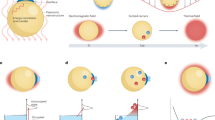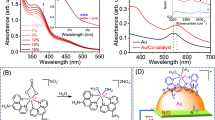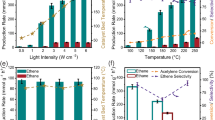Abstract
We successfully realised plasmon-driven selective reduction reactions of 2-amino-5-nitrobenzenethiol (2A-5-NBT) to 3,3’-dimercapto-4,4’-diaminoazobenzene , an azobenzene derivative, using surface-enhanced Raman scattering (SERS) spectroscopy and supported by the theoretical calculations. The SERS spectra demonstrated that two 5-nitro groups of 2A-5-NBTs were selectively reduced to the –N=N– chemical bond of 3,3’-dimercapto-4,4’-diaminoazobenzene, whereas the 2-amine group of 2A-5-NBT remained unchanged. Our experimental results revealed that aqueous environments were preferable to ambient atmospheric environments for this selective reduction reaction. The product is very stable in aqueous environments. However, in ambient atmosphere environments, the product is not stable and can revert back to 2A-5-NBT, where the –N=N– chemical bond can be broken by plasmon scissors. The plasmon-induced catalytic reactions in aqueous environments could be used for the efficient synthesis of aromatic azobenzene derivative compounds, which are valuable chemicals that are widely used in the chemical industry as dyes, food additives and drugs.
Similar content being viewed by others
Introduction
Surface plasmon resonance (SPR) is a collective oscillation of surface conduction electrons that is excited by incident light at specific photon energies. This phenomenon has been exploited in plasmon-driven chemical reactions1,2,3,4,5,6,7,8,9,10, which have attracted significant attention because of their high throughput and low energy requirements. Hot electrons with high kinetic energy have been generated from plasmon decay11,12. These hot electrons play a key role in plasmon-induced chemical reactions by providing the required electrons and energy for the reactions to proceed.
Recently, extensive studies have demonstrated that p-aminothiophenol (PATP) absorbed on metal nanostructures can be selectively transformed into a new azo species, p,p’-dimercaptoazobenzene (DMAB), by a plasmon-driven catalytic reaction13,14,15,16,17. In this oxidation reaction, two 4-amine (-NH2) groups of PATP are selectively coupled to a –N=N– chemical bond to form DMAB. A similar aromatic compound, 4-nitrothiophenol (4-NBT), can also be catalyzed into DMAB with the assistance of plasmons18,19,20,21. In this reduction reaction, two 4-nitro groups of 4-NBT are selectively reduced to an azo bond. The two aforementioned reactions are strongly affected by the nature of the substrate materials22, the irradiation wavelength and power23,24, the solution pH25 and the ambient atmosphere17 or aqueous enviroment26. However, the plasmon-enhanced catalysed reactions on metallic catalysts can be monitored and controlled by surface-enhanced Raman scattering (SERS)14,21 and tip-enhanced Raman spectroscopy (TERS)27.
2-amino-5-nitrobenzenethiol (2A-5-NBT, see Fig. 1a) is an interesting molecule that contains benzyl, amine, nitro and -SH groups. This molecule can be used to study the competition between plasmon-driven oxidation and reduction in different environments, e.g., aqueous or ambient atmospheric environments. These three different molecules, 2,2’-dimercapto-4,4’-dintroazobenzene, 3,3’-dimercapto-4,4’-diaminoazobenzene and 2,3’-dimercapto-4-nitro-4-amino-azobenzene (see Fig. 1b–d) could be oxidized or reduced by SPR. This molecule can also be used to determine the most stable environment for plasmon-driven chemical reactions.
In this study, we used SERS spectroscopy in conjunction with theoretical calculations to investigate the plasmon-driven selective reduction reaction of 2A-5-NBT, which was chemically absorbed on a roughened Ag substrate and was dimerized to a new azobenzene derivative compound, 3,3’-dimercapto-4,4’-diaminoazobenzene. This selective reduction reaction proceeded via the nitro group of 2A-5-NBT and thus, oxidation via the amine group of 2A-5-NBT did not occur. The product was very stable in aqueous environments. However, in ambient atmospheric environments, the product was not stable and reverted to 2A-5-NBT, where the resulting –N=N– chemical bond could be further dissociated by plasmon scissors.
Our findings provide a novel environmentally friendly synthetic method for forming azobenzene derivative compounds, which are important and valuable industrial dyes28 and have potential applications as molecular wires and switches in molecular electronics29,30,31.
Results
Characterisation of SERS-active substrates
The substrate for the SERS measurements was prepared using a previously reported method26. The SEM image (Fig. 2) of the roughened Ag electrode shows three-dimensional (3D) “hot spots” or 3D nanogaps26. The SEM image shows that the substrate was roughened along and perpendicular to the surface. This structure increased the number of “hot spots” and the intensity of the SPR for the plasmon-driven chemical reactions32.
Plasmon-driven chemical reactions in an aqueous environment
Figure 3(a) and (b) shows the measured Raman spectrum of the 2A-5-NBT powder and the corresponding simulated Raman spectrum, respectively, which are in good agreement. The theoretical calculations showed that the strongest Raman peak at 1302 cm−1 in Fig. 3(a) could be attributed to the -NO2 stretching mode of 2A-5-NBT.
Figure 3(c) shows the SERS spectrum of 2A-5-NBT that was measured in an aqueous environment. The profiles in Fig. 3(a) and (c) are significantly different from each other. SPR-assisted chemical reactions appear to have occurred for 2A-5-NBT in the aqueous environment. As discussed in the Introduction section, three types of molecules can be synthesised by different reduction or oxidation reactions. The simulated Raman spectrum for 3,3’-dimercapto-4,4’-diaminoazobenzene is shown in Fig. 3(d). When compared, Fig. 3(c) and (d) clearly shows that 2A-5-NBT was selectively reduced to 3,3’-dimercapto-4,4’-diaminoazobenzene via two nitro groups from 2A-5-NBT molecules, whereas the 2-amine group of 2A-5-NBT was unchanged. The vibrational modes of the strong Raman peaks of 3,3’-dimercapto-4,4’-diaminoazobenzene are shown in Fig. 4, where the peak at 1436 cm−1 was attributed to the –N=N– stretching mode.
We studied the stability of plasmon-driven selective reductive reactions by measuring the time-dependent sequential SERS spectra in an aqueous environment (see Fig. 5). These plasmon-driven selective reduction catalysis reactions were found to be very efficient and the resulting product was very stable.
Plasmon-driven chemical reactions in an ambient atmosphere environment
We studied the effect of different environments on plasmon-driven selectively catalysed reactions by measuring the time-dependent sequential SERS spectra (see Fig. 6). At the initial stages of the chemical reaction, the reactant 2A-5-NBT was clearly observed (see the upper spectrum in Fig. 6). With increasing time, 2A-5-NBT was selectively catalysed to 3,3’-dimercapto-4,4’-diaminoazobenzene (see the lower spectrum in Fig. 6). Subsequent SERS measurements showed that the product reverted to the reactant via the dissociation of the –N=N– chemical bond by plasmon scissors. There have been several reports on the dissociation of the –N=N– chemical bond by plasmon scissors using SERS33 and TERS34.
Discussion
2A-5-NBT contains an amine group (–NH2) and a nitro group (–NO2); hence, it is difficult to ascertain which nitrogenous group participates in the selective formation of the azo bond. We considered three potential coupling modes in simulating the Raman spectra of the corresponding products 2,2’-dimercapto- 4,4’-dintroazobenzene, 3,3’-dimercapto-4,4’-diaminoazobenzene and 2,3’-dimercapto-4-nitro-4-amino-azobenzene (see Fig. 7(a)–(c)), which are denoted as molecules A, B and C, respectively. The molecular structure graph of molecule A in Fig. 7(a) shows that a –N=N– chemical bond could form at the 2’2 coupling via two 2-amine groups from 2A-5-NBT molecules. Similarly, a second possible molecule B (see Fig. 7(b)) could be selectively produced through the coupling of two 5-nitro groups of 2A-5-NBT molecules. The plasmon could also convert the 2A-5-NBT to a third possible product, C, (see Fig. 7(c)) by the selective coupling of a 2-amine group and a 5-nitro group of 2A-5-NBT.
We determined the selected product from the plasmon-driven catalytic coupling reaction by comparing the SERS spectrum of 2A-5-NBT on the roughened Ag substrate with the calculated Raman spectra for the three products. For molecules A and C, the strong Raman peaks at approximately 1330 cm−1 were attributed to the NO2 stretching modes (see Fig. 8) that were not observed in the experimental results in Figs 3(c) and 5, which is a distinct and unique experimental signature. The simulated Raman spectrum in Fig. 7b was consistent with the experimental SERS spectrum in Fig. 3(c). Thus, we concluded that 2A-5-NBT was selectively reduced to 3,3’-dimercapto-4,4’-diaminoazobenzene. The reduction reaction occurred before the oxidation of the molecules with amine and nitro groups. Different environments were found to strongly influence the stability, probability and efficiency of selective catalysis reactions by plasmons.
Methods
2A-5-NBT was purchased from Beijing Kaida Co., according to the customer’s requirements. The NMR spectrum of 2A-5-NBT is presented in the supporting information.
The Ag substrate (a single-crystal silver rod of 99.99% purity) was polished with emery paper and cleaned with Milli-Q water in an ultrasonic bath. The Ag substrate was then placed in a typical electrochemical cell containing a 0.1 M Na2SO4 solution for roughening. A double potential step was used to roughen the surface by applying a voltage of +0.25 V for 8 s and then applying a voltage of −0.35 V.
The Raman spectrum of the 2A-5-NBT powder and the SERS spectrum of 2A-5-NBT (1  10−6 M) were measured using Raman spectroscopy (Renishaw inVia system) with a laser incident wavelength of 632.8 nm.
10−6 M) were measured using Raman spectroscopy (Renishaw inVia system) with a laser incident wavelength of 632.8 nm.
All of the theoretical calculations were performed with the Gaussian 09 suite using density functional theory35 and the PW91PW91 functional36 with b3lyp/6-311++g(d,p) for the reactant and the 6-31G(d) basis set for the three products.
Additional Information
How to cite this article: Ding, Q. et al. Effect of aqueous and ambient atmospheric environments on plasmon-driven selective reduction reactions. Sci. Rep. 5, 10269; doi: 10.1038/srep10269 (2015).
References
Chen, C. J. & Osgood, R. M. Near-field photochemical imaging of noble metal nanostructures. Phys. Rev. Lett. 50, 1705 (1983).
Hubert, C. et al. Near-field photochemical imaging of noble metal nanostructures. Nano Lett. 5, 615–619 (2005).
Tsuboi, Y., Shimizu, R., Shoji, T. & Kitamura, N. Near-infrared continuous-wave light driving a two-photon photochromic reaction with the assistance of localized surface plasmon. J. Am. Chem. Soc. 131, 12623–13267 (2009).
Zhu, H., Ke, X., Yang, X., Sarina, S. & Liu, H. Reduction of nitroaromatic compounds on supported gold nanoparticles by visible and ultraviolet light. Angew. Chem. Int. Ed. 49, 9657–9661 (2010).
Christopher, P., Xin, H. & Linic, S. Visible-light-enhanced catalytic oxidation reactions on plasmonic silver nanostructures. Nature Chem. 3, 467–472 (2011).
Xie, W., Herrmann, C., Kompe, K., Haase, M. & Schlucker, S. Synthesis of bifunctional Au/Pt/Au Core/Shell nanoraspberries for in situ SERS monitoring of Platinum-catalyzed reactions. J. Am. Chem. Soc. 133, 19302–19305 (2011).
Navalon, S., de Miguel, M., Martin, R., Alvaro, M. & Garcia, H. Enhancement of the catalytic activity of supported gold nanoparticles for the Fenton reaction by light. J. Am. Chem. Soc. 133, 2218–2226 (2011).
Silva, C. G., Juarez, R., Marino, T., Molinari, R. & Garcıa, H. Influence of excitation wavelength (UV or visible light) on the photocatalytic activity of titania containing gold nanoparticles for the generation of hydrogen or oxygen. J. Am. Chem. Soc. 133, 595–602 (2011).
Wadayama, T. & Yokawa, M. Hot-electron assisted reaction of p-nitrobenzoic acid adsorbed on metal–insulator–metal tunnel junction’s electrode surface. Chem. Phys. Lett. 428, 348–351 (2006).
Lee, J. et al. Plasmonicphotoanodes for solar water splitting with visible light. Nano Lett. 12, 5014–5019 (2012).
Knight, M., W., Sobhani, H., Nordlander, P. & Halas, N. Photodetection with active optical antennas. Science 332, 702–704 (2011).
Zhang, Z. L. et al. Insights into the nature of plasmon-driven catalytic reactions by HV-TERS. Nanoscale. 5, 3249–3252 (2013).
Wu, D. Y., et al. Surface catalytic coupling reaction of p-Mercaptoaniline linking to silver nanostructures responsible for abnormal SERS enhancement: a DFT study. J. Phys. Chem. C. 113, 18212–18222 (2009).
Fang Y., Li, Y., Xu, H. X. & Sun, M. T. Ascertaining p, p’-dimercaptoazobenzene produced from p-aminothiophenol by selective catalytic coupling reaction on silver nanoparticles. Langmuir. 26, 7737–7746 (2010).
Huang, Y. F. et al. When the signal is not from the original molecule to be detected: chemical transformation of para-aminothiophenol on Ag during the SERS measurement. J. Am. Chem. Soc. 132, 9244–9246 (2010).
Xu, P. et al. Mechanistic understanding of surface plasmon assisted catalysis on a single particle: cyclic redox of 4-aminothiophenol. Sci. Rep. 3, 2997 (2013).
Huang, Y. F. et al. Activation of Oxygen Gas on Au and Ag Nanoparticles Assisted by Surface Plasmon Resonances. Angew. Chem., Int. Ed. 53, 2353–2357 (2014).
Dong, B., Fang, Y. R., Xia, L. X., Xu, H. X. & Sun, M. T. Is 4-nitrobenzenethiol converted to p,p’-dimercaptoazobenzene or 4-aminothiophenol by surface photochemistry reaction? J. Raman Spectrosc. 42, 1205–1206 (2011).
Sun, M. T. & Xu, H. X. A novel application of plasmonics: plasmon driven surface catalyzed reactions. Small 8, 2777–2786 (2012).
van S. Lantman, E. M., Deckert-Gaudig, T., Mank, A. J. G., Deckert, V. & Weckhuysen, B. M. Catalytic processes monitored at the nanoscale with tip enhanced Raman spectroscopy. Nature Nanotech. 7, 583–586 (2012).
Xie, W., Walkenfort, B. & Schlucker, S. Label-Free SERS Monitoring of Chemical Reactions Catalyzed by Small Gold Nanoparticles Using 3D Plasmonic Superstructures. J. Am. Chem. Soc. 135, 1657–1660 (2013).
Dong, B. et al. Substrate-, wavelength- and time-dependent plasmon-assisted surface catalysis reaction of 4-nitrobenzenethiol dimerizing to p,p’-dimercaptoazobenzene on Au, Ag and Cu films. Langmuir, 27, 10677–10682 (2011).
Kang, L. L. et al. Laser wavelength- and power-dependent plasmon-driven chemical reactions monitored using single particle surface enhanced Raman spectroscopy. Chem. Comm. 49, 3389–3391 (2013).
Wang, H. et al. Plasmon-driven surface catalysis in hybridized plasmonic gap modes. Sci. Rep. 4, 7087 (2014).
Ji, W. et al. PH-response mechanism of p-aminobenzenethiol on Ag nanoparticles revealed by two-dimensional correlation surface enhanced Raman scattering spectroscopy. J. Phys. Chem. Lett. 3, 3204–3209 (2012).
Zhang, X. et al. Plasmon-driven sequential chemical reactions in an aqueous environment. Sci. Rep. 4, 5407 (2014).
Sun, M. T., Zhang, Z. L., Zheng, H. R. & Xu. H. X. In-situ plasmon-driven chemical reactions revealed by high vacuum tip-enhanced Raman spectroscopy. Sci. Rep. 2, 647 (2012).
Venkataraman, K. in The Chemistry of Synthetic Dyes. (Academic Press, London, 1970).
Nowak, A. M. & McCreery, R. L. In situ Raman spectroscopy of bias-induced structural changes in nitrozaobenzene molecular electronic junctions. J. Am. Chem. Soc. 126, 16621–16631 (2004).
Vives, G. & Tour, J. M. Acc. Chem. Res. Synthesis of single-molecule nanocars . Acc. Chem. Res. 42, 473–487 (2009).
McCreery, R. L. Molecular electronic junctions. Chem. Mater. 16, 4477–4496 (2004).
Cui, L. et al. Plasmon-driven dimerization via S-S chemical bond in an aqueous environment. Sci. Rep. 4, 7221 (2014).
Kim, K., Kim, K. L. & Shin, K. S. Photoreduction of 4,4′-Dimercaptoazobenzene on Ag Revealed by Raman Scattering Spectroscopy. Langmuir 29, 183–190 (2013).
Sun, M. T. et al. Plasmonic Scissors for Molecular Design. Chem. Eur. J. 19, 14958–14962 (2013).
Parr, R. G. & Yang, W. Density-functional theory of atoms and molecules (Oxford Univ. Press, Oxford, 1989).
Perdew, J. P., Burke, K. & Wang, Y. Jacob’s ladder of density functional approximations for the exchange-correlation energy. Phys. Rev. B 54, 16533 (1996).
Acknowledgements
This work was supported by the National Natural Science Foundation of China (Grant Nos. 91436102, 11374353, 11474141, 11374045, 11404055 and 61137005), the Program for New Century Excellent Talents in University (Grant No. NCET-12-0077), the Program of Liaoning Key Laboratory of Semiconductor Light Emitting and Photocatalytic Materials and the Heilongjiang Provincial Youth Science Foundation (Grant No. QC2013C006).
Author information
Authors and Affiliations
Contributions
M.S., M.C. and Y.L. supervised the project; Q.D. performed the SERS measurements; Q.D., T.S. and M.C. analysed the data and M.S. and Q.D. wrote the manuscript.
Ethics declarations
Competing interests
The authors declare no competing financial interests.
Electronic supplementary material
Rights and permissions
This work is licensed under a Creative Commons Attribution 4.0 International License. The images or other third party material in this article are included in the article’s Creative Commons license, unless indicated otherwise in the credit line; if the material is not included under the Creative Commons license, users will need to obtain permission from the license holder to reproduce the material. To view a copy of this license, visit http://creativecommons.org/licenses/by/4.0/
About this article
Cite this article
Ding, Q., Chen, M., Li, Y. et al. Effect of aqueous and ambient atmospheric environments on plasmon-driven selective reduction reactions. Sci Rep 5, 10269 (2015). https://doi.org/10.1038/srep10269
Received:
Accepted:
Published:
DOI: https://doi.org/10.1038/srep10269
This article is cited by
-
Effect of Reaction Conditions on the Characterization of Plasmon-Driven Surface Catalytic Reduction Reaction for Para-nitroaniline in a Liquid Condition
Plasmonics (2020)
-
Selective plasmon-driven catalysis for para-nitroaniline in aqueous environments
Scientific Reports (2016)
-
Surface-Enhanced Raman Spectroscopy Assisted by Radical Capturer for Tracking of Plasmon-Driven Redox Reaction
Scientific Reports (2016)
Comments
By submitting a comment you agree to abide by our Terms and Community Guidelines. If you find something abusive or that does not comply with our terms or guidelines please flag it as inappropriate.











